DIY Car Air Fresheners That Last
Table of Contents
how to make a air freshener for cars? that actually smells good and reflects your vibe, you’re in the right place. Forget the mass-produced pine trees — this is all about creating scents that feel personal and last longer than a servo special.
A DIY freshener doesn’t just save you a few bucks — it’s customisable, eco-friendly, and weirdly satisfying. “Scent is the strongest tie to memory,” says Aussie aromatherapist Sarah Murray — so why not make your car smell like something you actually want to remember?
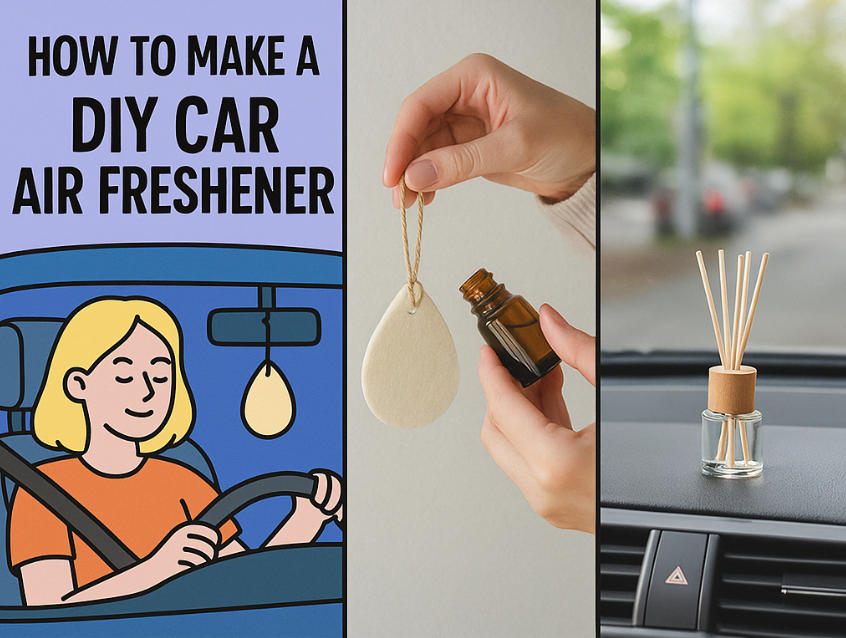
From choosing the right materials and oils to nailing scent longevity, we’ll walk you through 8 practical and creative ways to sort your car’s air game — no fluff, no fancy gear, just solid know-how.
Types of DIY Fresheners
There’s more than one way to keep your car smelling schmick. Here are the top DIY freshener types Aussies love to make and hang.
Felt and fabric fresheners explained
Felt fresheners are a classic choice—lightweight, cheap, and highly absorbent. Just cut shapes from felt or fabric, soak them in essential oils, and hang. The porous texture allows for slow fragrance diffusion, and you can recharge them with a few drops anytime they start to fade. Fabric fresheners are ace for adding visual flair too—pick a material that matches your car’s vibe. Pro tip: Layer scents with care to avoid overpowering whiffs.

Bead-based air fresheners overview
Bead-based fresheners, often made from aroma or polymer beads, are real troopers when it comes to scent strength. Here’s how they stack up:
| Bead Type | Scent Lifespan (days) | Best Use Location |
|---|---|---|
| Polymer beads | 25–30 | Under car seats |
| Gel beads | 15–20 | Cup holders |
| Fragrance beads | 20–25 | Glove box or boot area |
These DIY air freshener beads absorb fragrance oil and release it slowly over time, making them ideal for hotter climates where scent diffusion accelerates.
Diffuser bottle fresheners for rearview mirrors
Fill a small diffuser bottle with fragrance oil.
Insert a wooden cap or reed that allows the oil to wick up.
Tie it around your rearview mirror — and you’re sorted.
These hanging diffusers are not just an auto accessory; they double as classy decor and deliver a subtle, steady car fragrance for weeks. As perfumer Tanya Reid notes, “The slow release of oil in hanging diffusers makes them perfect for confined car interiors.”
Essential Materials List
Before you dive into DIY fresheners, knowing what gear to grab makes the job quicker, cheaper, and way less frustrating.
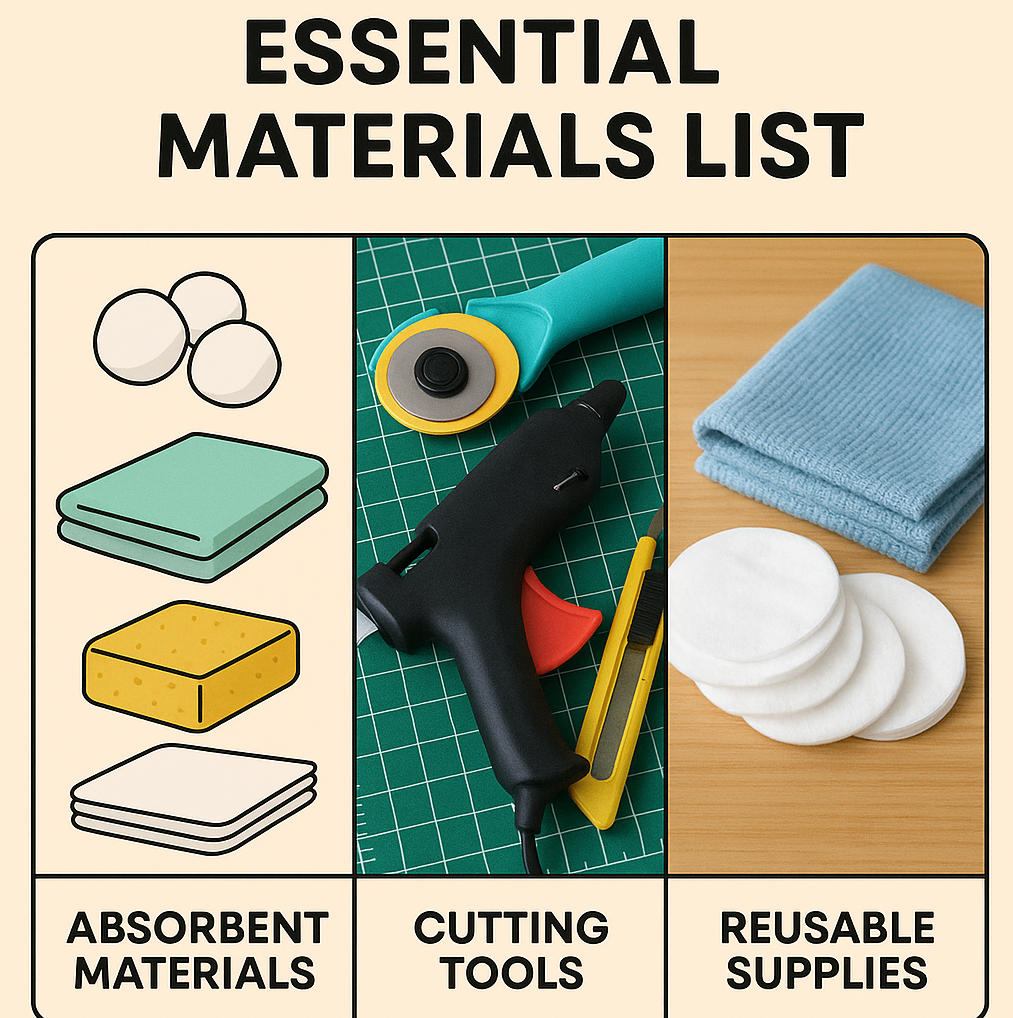
Types of absorbent materials to buy
You’ll want materials that hold scent well without leaking or falling apart. Here’s a quick guide:
| Material | Absorbency Level | Best Use Case |
|---|---|---|
| Cotton balls | High | Small jar diffusers |
| Terry cloth | Medium-High | Hanging air fresheners |
| Sponge | Medium | Under-seat placement |
| Paper towels | Low | Quick, disposable use |
Avoid synthetic fabrics — they don’t soak up oils properly and tend to break down with time.
Must-have tools for cutting and sealing
Getting a clean finish isn’t just about looks — it helps your freshener last longer too. Here’s your essential toolkit:
Rotary cutter & cutting mat: perfect for shaping felt or sponge sheets
Fabric glue or hot glue gun: seals edges and secures scent pads
Craft knife: ideal for tight corners or intricate shapes
Adhesive spray: good for bonding layers without bleeding oils
Quote: “Using sharp shears or rotary blades can really level-up your finish — no fraying, no fluff,” says Jess Tanner, DIY supply specialist from CraftWorld AU.
Reusable vs disposable supplies breakdown
Let’s talk longevity. You don’t want to be making new ones every other week unless you love it.
Reusable wins: microfiber cloths, cotton pads, dusting mitts
Disposable’s good for quick jobs: wipes, paper towels, cotton swabs
Avoid overlap: don’t mix tools for cleaning with your freshener supplies — you’ll mess up the scent or oil transfer.
Mate, reusable might be dearer up front, but it’ll save you coin in the long run — and less bin overflow too.
Where to find cheap bulk materials
Stocking up smart means better savings. Here’s where to scout:
Online marketplaces – eBay, Amazon, and AliExpress have heaps
Craft stores – check clearance bins for fabric offcuts
Janitorial supply shops – sponges, wipes, gloves in bulk
Discount retailers – think Kmart or The Reject Shop
Restaurant supply wholesalers – surprisingly handy for absorbent pads and storage containers
Keep an eye on local closeout sales too — you’d be surprised what pops up for a fiver.
How to Make Tree-Shaped Fresheners?
“I have made over a hundred of these for markets,” says Carly Benson, a Melbourne-based craft seller who specialises in handmade car accessories. “People love the classic look, and it is dead easy once you have your setup.” Her top tip? Choose a tree shape template that feels nostalgic — not just functional.
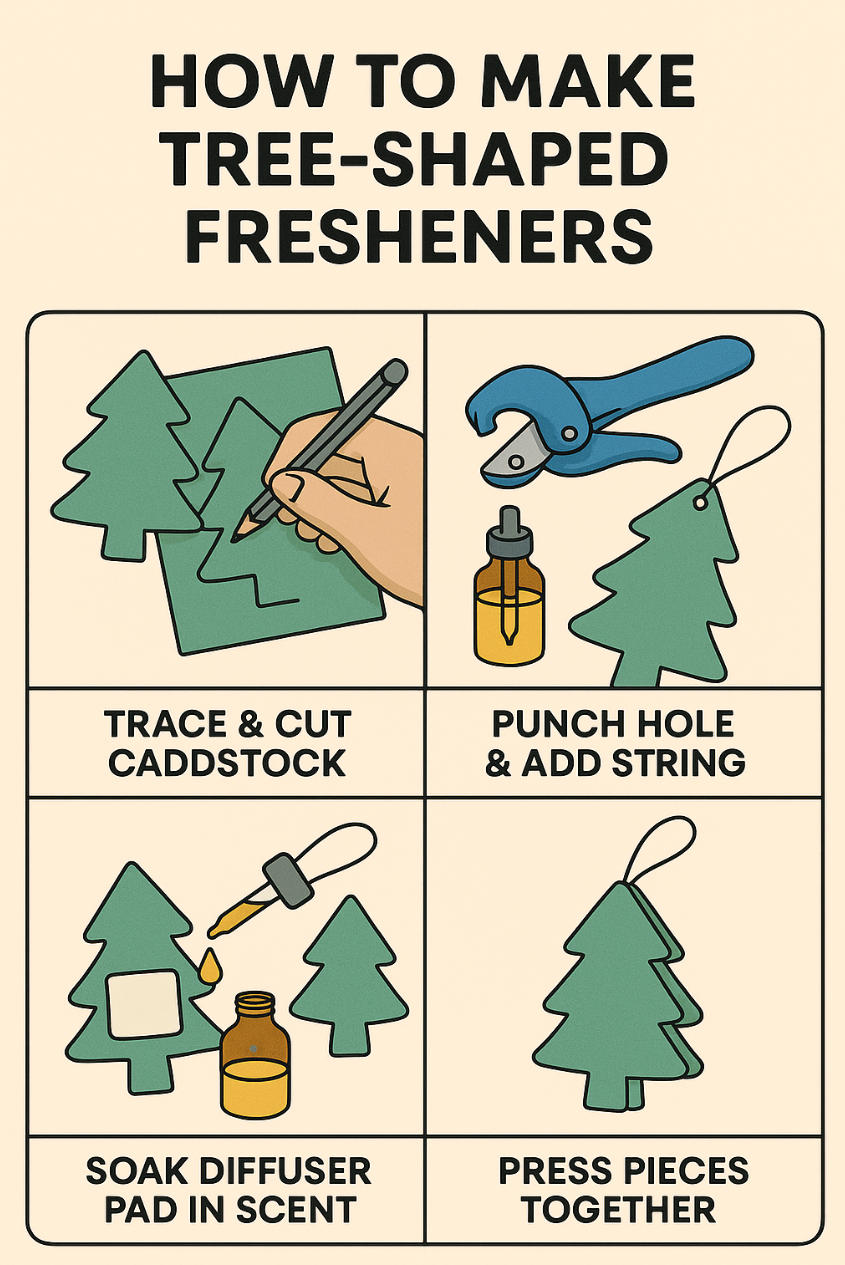
To start, place a sheet of sturdy cardstock on your bench, then trace your cookie cutter or tree shape template. Cut it out using clean scissors, and punch a neat hole at the top using a hole punch. Next, tie a short elastic string loop through the hole for easy hanging.
For scenting, soak a small diffuser pad or a piece of fabric scrap in your favourite scented oil or essential oils. Popular choices in warmer Aussie regions include eucalyptus, lemongrass, and peppermint — all known for longevity and car-safe freshness. Carly uses “lavender and vanilla oil blends — they smell fresh, not overpowering.”
According to Dr. Leo Watterson, a certified aromatherapist and contributor to Natural Scents AU, “Natural fibre pads hold essential oils better and release the scent more steadily, especially in enclosed spaces like vehicles.” For best results, tuck the scented element between two cardstock cutouts and press them together firmly.
This method uses simple gear and materials available in most craft stores or online from verified sellers. Always check for product certifications, especially for essential oils marketed as vehicle-safe.
Which Essential Oils Work Best?
Choosing the right essential oils for your car freshener isn’t just about the smell — it’s about longevity, mood, and how well they hold up on the road.
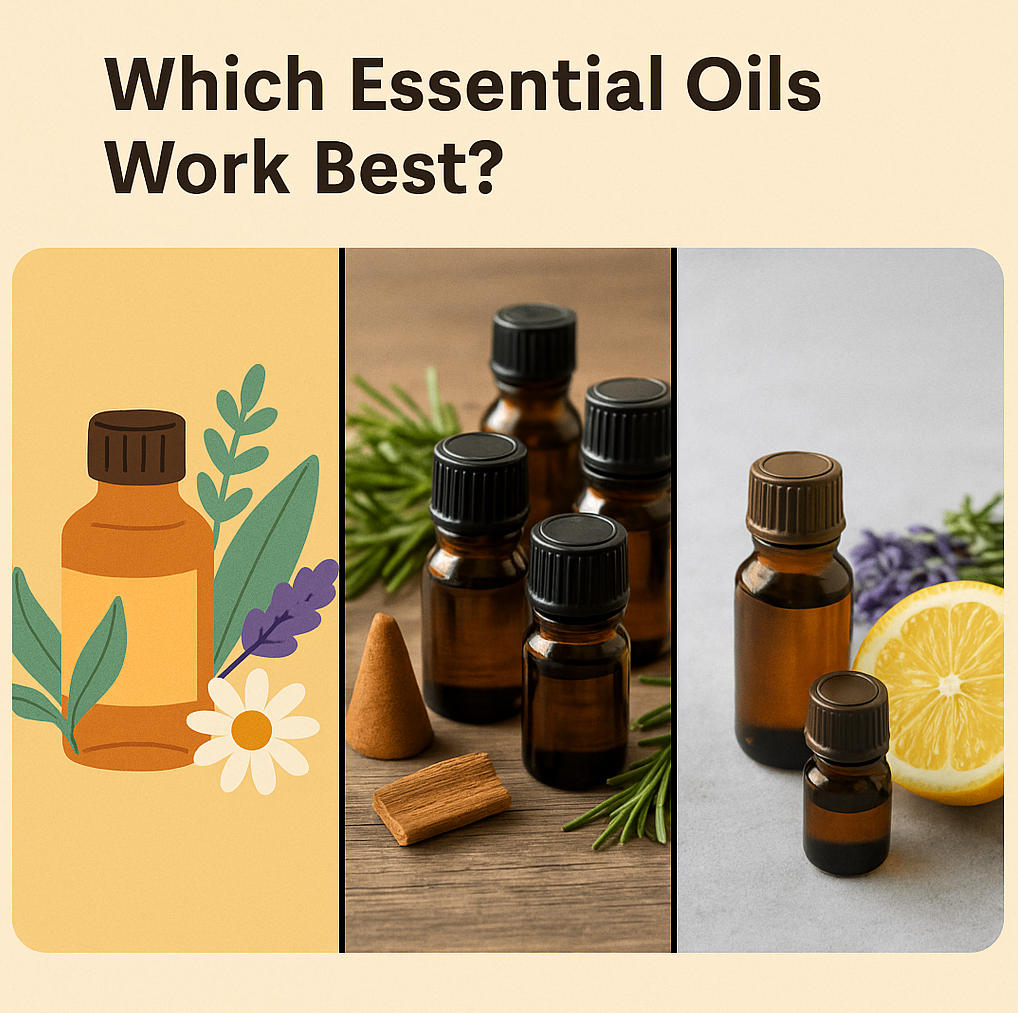
Long-lasting essential oils for hot climates
If your car's parked under the Aussie sun, you’ll want oils that don’t vanish faster than a servo pie. Heat stability and evaporation rate matter big time in tropical climates and arid regions.
Top oils that punch above their weight in hot conditions:
Sandalwood – earthy, stable, long-lasting
Vetiver – thick, grassy, low volatility
Patchouli – deep and lingering, heat-friendly
Cedarwood & Myrrh – both offer good scent longevity
Frankincense – resinous and resistant to high temps
💡 “In hotter regions, diffusion methods like felt pads or passive diffusers help preserve oil integrity,” says aromatherapy expert Dr. Lina Hardy.
Calming vs energising scents for drivers
We all know long drives can be a bit of a snooze or send stress through the roof. The trick? Match your scent to your mood or driving needs.
Relax and unwind:
Lavender and Chamomile – perfect for peak-hour chill sessions
Bergamot – soothes anxiety without knocking you out
Stay sharp behind the wheel:
Peppermint – wakes up your senses
Lemon and Rosemary – help boost alertness, focus, and reduce driver fatigue
Pro tip: Use car diffusers that let you swap blends depending on the trip. Long commute? Go energising. Late-night drive? Calming vibes all the way.
Sublimation Freshener Guide
Sublimation car fresheners are all the rage—sleek, personal, and long-lasting. Here’s your shortcut guide to nailing your first print without wasting cash or blank stock.
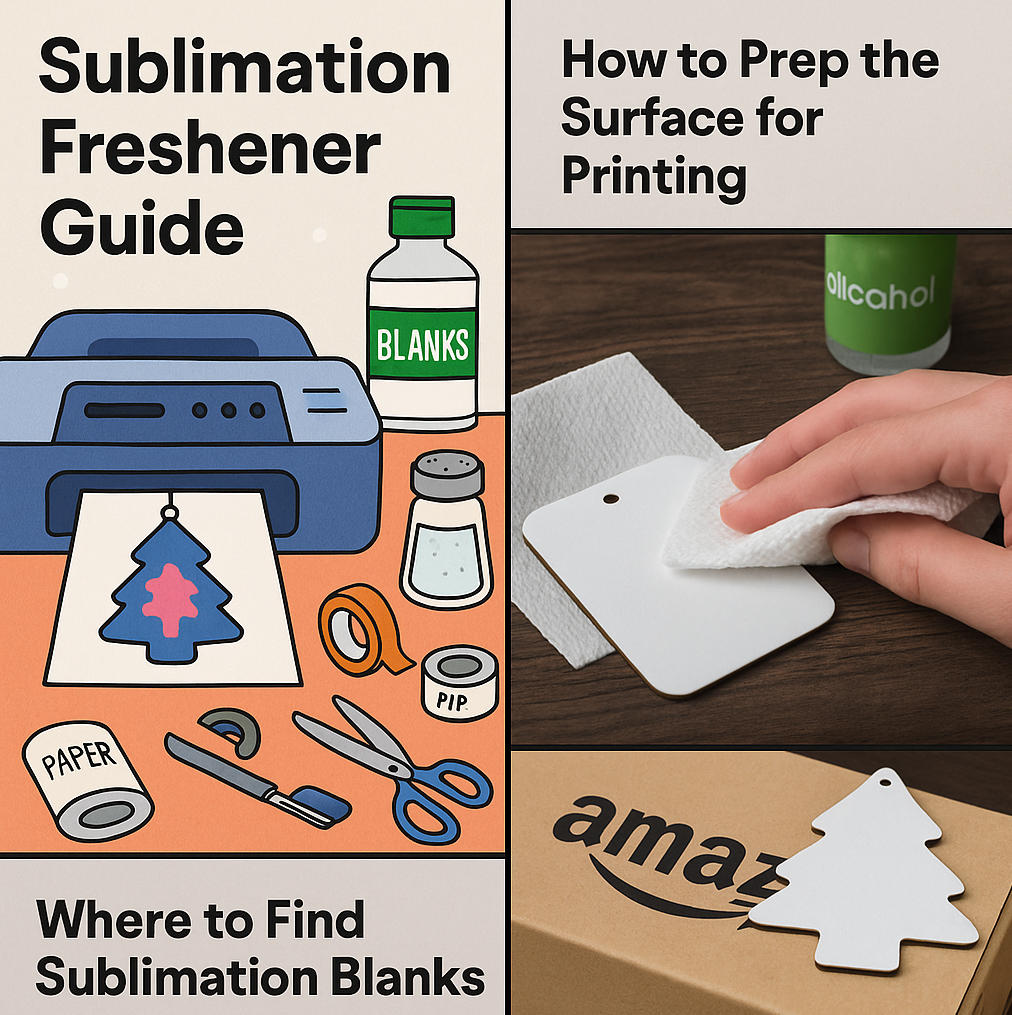
Materials needed for sublimation printing
You’ll need more than just a good idea—gear matters here.
Sublimation printer with sublimation ink (standard ink won’t cut it)
Sublimation paper and a heat press
Heat resistant tape and protective paper
A stash of sublimation blanks, like felt or hardboard
Design software and a reliable computer
Tip: Don’t skimp on quality—cheap paper leads to ghosting.
How to prep the surface for printing
Start with surface cleaning — wipe with alcohol to remove any oils or dust particles.
Use a lint roller for fabric-based blanks.
Pre-press your blank (5–10 seconds at low pressure) to remove moisture.
Set correct heat press settings: temperature, time, and pressure vary by material.
Align design carefully before pressing — misalignment is nearly impossible to fix later.
Where to find sublimation blanks
Here’s where to hunt:
| Source | Minimum Order | Variety Available |
|---|---|---|
| Amazon | 1 unit | High |
| Alibaba | 50 units | Very High |
| Local craft stores | 1–5 units | Low to Medium |
For bulk projects, Alibaba or wholesale suppliers are king. For hobbyists, craft stores work a treat.
Artwork file tips for crisp designs
• Design in high resolution (300+ DPI) for sharp lines. • Use vector graphics when possible—scales without fuzziness. • Export files in CMYK for accurate sublimation colours. • Mirror image your design before printing! • Save as PNG or PDF for clean output.
💡 Quote: “Bad artwork can ruin a flawless print—always preview before you press,” says Mel Tan, founder of Brisbane Print Lab.
DIY vs outsourcing sublimation prints
Some folks love the grind, others prefer buying in bulk. Here’s the breakdown:
DIY means customization, lower long-term cost, and creative control.
Outsourcing offers faster turnaround time and skips the learning curve, but can get pricey with small batches.
If you’re printing fewer than 20 pieces a month, outsourcing may be smarter.
Need full control or plan to scale up? Invest in gear and own the process.
Which DIY Lasts the Longest?
Not all DIY air fresheners are created equal. Let’s size up which ones actually go the distance — because no one wants a scent that disappears by the weekend.
Comparing scent retention by material
Different materials absorb and hold scent differently — it’s not just about what looks good dangling from your mirror.
Fabrics like felt or cotton hold scent well due to their porous texture, making them top picks for strong retention.
Plastic and metal tend to be poor at absorption but may work if paired with strong adhesive scent gels.
Glass surfaces, especially in diffuser bottles, offer excellent scent diffusion over time but require airtight sealing.
| Material Type | Scent Retention (Days) | Porosity Level |
|---|---|---|
| Felt | 10–14 | High |
| Plastic | 3–5 | Low |
| Glass Bottle | 12–16 | Medium |
Tip: Look for natural textiles with open fibers for better scent hold.
Most fade-resistant oils for car use
Let’s talk oils — because some just give up too quickly in Aussie summer heat.
Cedarwood and patchouli: These base-note oils are known for their long-lasting nature and lower volatility.
Synthetic blends: Designed for automotive use, many include UV-stable additives to slow scent degradation.
Citrus oils (like lemon or orange) might smell fresh but they’re flighty — usually gone in a few days.
“For longevity, choose oils with low evaporation rates and high flash points,” recommends chemist Dr. Jules Warwick, who studies scent retention in vehicle environments.
A bit of savvy oil picking can make your freshener last twice as long without needing a top-up.
How to Refill a Freshener?
Refilling your car air freshener doesn’t need to be fiddly or expensive. Here’s how to keep the scent going strong without chucking the whole thing out.
When to reapply oils or scents
Scent longevity depends on more than just the oil. Factors like room size, ventilation, and seasonal changes all play a role.
Light, citrus oils may fade in 5–7 days
Heavier scents (like patchouli) can last up to 3 weeks
Reapplication frequency varies — trust your nose and adjust for personal preference Aroma fading faster in summer? Blame temperature and airflow boosting essential oil diffusion.
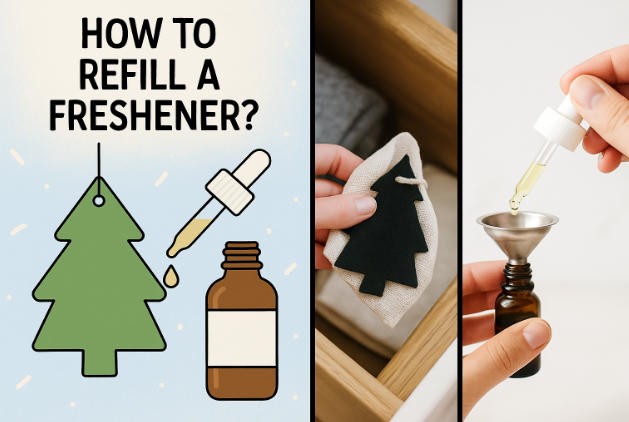
Safe ways to reuse old fresheners
No need to bin that worn-out car air freshener — give it a second life! You can:
Wrap it in muslin and toss it into a sock drawer as a scent sachet
Add a few drops of non-toxic essential oils and place it under the seat as a hidden odor eliminator
Tips to avoid scent layering issues
Mixing smells ain’t like mixing paint — sometimes it gets weird, fast. Avoid that funky overlap by:
Picking oils from the same scent family
Giving the old scent time to fully fade
Using ventilation to reset the space before changing aromas
Trying complementary notes like lemon + lavender or sandalwood + vanilla for aroma harmony As perfumer Ellie Tran puts it, “If it clashes in a candle shop, it’ll clash in your car.”
Tools for easy refill at home
Having the right gear makes DIY refills a breeze:
| Tool | Use Case | Bonus Tip |
|---|---|---|
| Dropper bottle | For precise oil reapplication | Avoid spills and sticky hands |
| Mini funnel | Helps with dry materials | Fits inside small-neck containers |
| Measuring cup | Ensures consistent blending | Mark your oil-to-carrier ratio |
Other handy items: spray bottles, refill kits, and small storage containers to prep your scents in advance.
Natural vs. Synthetic Scents
"When customers ask what goes into our air fresheners, I tell them straight — not all scents are made equal," says Reece Turner, founder of an independent fragrance lab based in Melbourne. "Natural essential oils bring complexity, while synthetic compounds bring consistency — the trick is knowing what suits your needs."
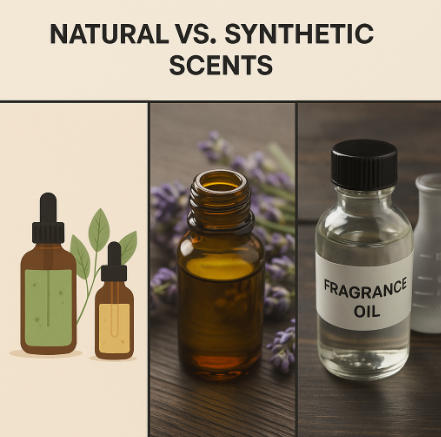
Natural ingredients such as lavender, eucalyptus and citrus are often extracted through cold-pressing or steam distillation, giving them rich aroma profiles without added chemical additives. Fragrance oils, on the other hand, are lab-crafted blends that mimic natural scents or create entirely new ones. These often include phthalates or stabilisers to enhance longevity.
Concerns around allergens and safety continue to drive this debate. Natural oils may trigger sensitivities in some users, while synthetic variants are scrutinised for chemical residues. Healthline Australia notes that synthetic scents with phthalates have been flagged for potential respiratory irritation.
Essential oils: pure, plant-based, aroma varies by batch
Fragrance oils: consistent scent, longer-lasting, may include synthetic compounds
Longevity: synthetics often outperform naturals in car environments
Safety concerns: both types can trigger allergies if not handled properly
"I personally lean toward blends with fewer chemical additives," shares Jess Huang, a Sydney-based aromatherapist. "You just need to check the source and choose based on the space you're using it in."
Conclusion
Making a car air freshener isn’t rocket science — it’s more like brewing your own cuppa: personal, simple, and surprisingly satisfying. With a few tools and a bit of scent know-how, you can ditch those plastic pine trees for something that actually suits your style.
“A scent can shift your whole mood,” says Melbourne-based scent designer Lani Fields. “Why not let it be one you love?”
Great question! If you want a long-lasting DIY air freshener, you’ll want to use materials that hold oil without leaking and release scent slowly. Top choices include:
Felt or thick cotton fabric
Aroma beads (used with fragrance oils)
Unglazed ceramic discs
Wooden cutouts (especially sandalwood or pine)
Yep, you absolutely can. Fragrance oils are a budget-friendly option, often stronger-smelling and longer-lasting than pure essential oils. Just check the label to ensure it’s safe for use in enclosed spaces like a car.
On average, 2 to 4 weeks — but it depends on:
Give it a top-up when the scent starts to fade.
Type of material used
Scent strength and oil concentration
How often your car is in the sun
Air circulation in the car
Some essential oils (like eucalyptus and tea tree) can be toxic to dogs or cats, especially in enclosed spaces. If your furry mate’s riding shotgun often, go scent-free or use pet-safe essential oils like lavender in very small amounts.
Keep it palm-sized — around 7–10 cm tall is ideal. Anything too big will look bulky hanging from the mirror, and anything too small won’t hold enough oil.
Absolutely. Most DIY versions are no-sew! You can:
Cut shapes with scissors
Use hole punches for string holes
Apply glue or just tie off the string
Add scents directly — no stitching needed
Not by themselves. Sublimation is all about the design, not the smell. You’ll still need to add fragrance manually using oils or sprays if you want scent along with style.
A few common culprits:
Try switching to felt or beads, and reapply oils weekly.
Low-quality oils or not enough used
Material isn't holding the scent well
Hot weather evaporating it too quickly
You’re not sealing or storing it properly

Leave a comment